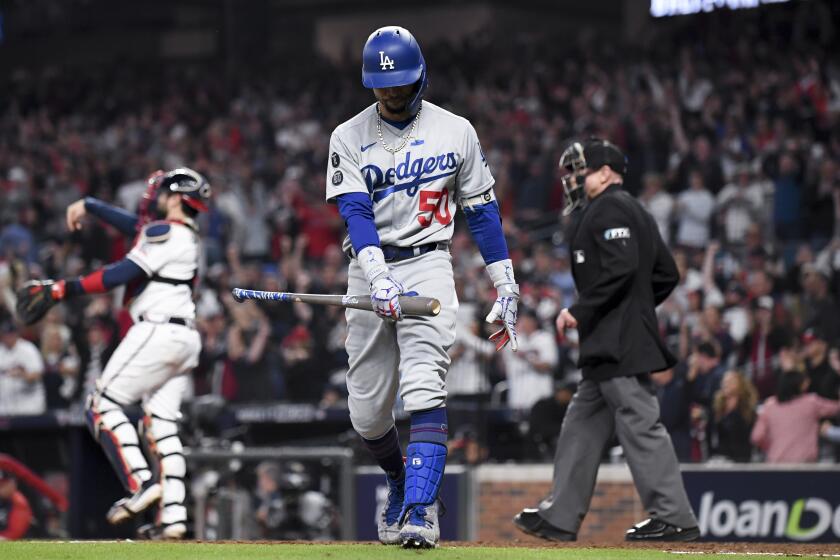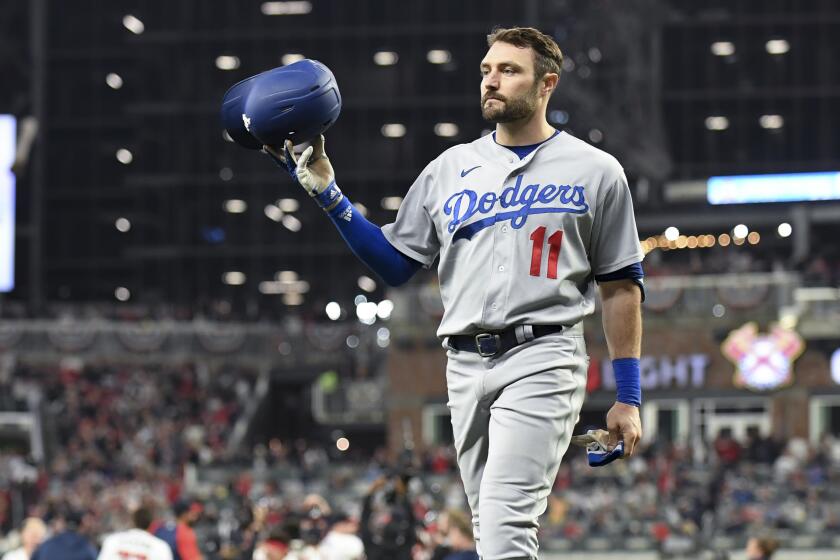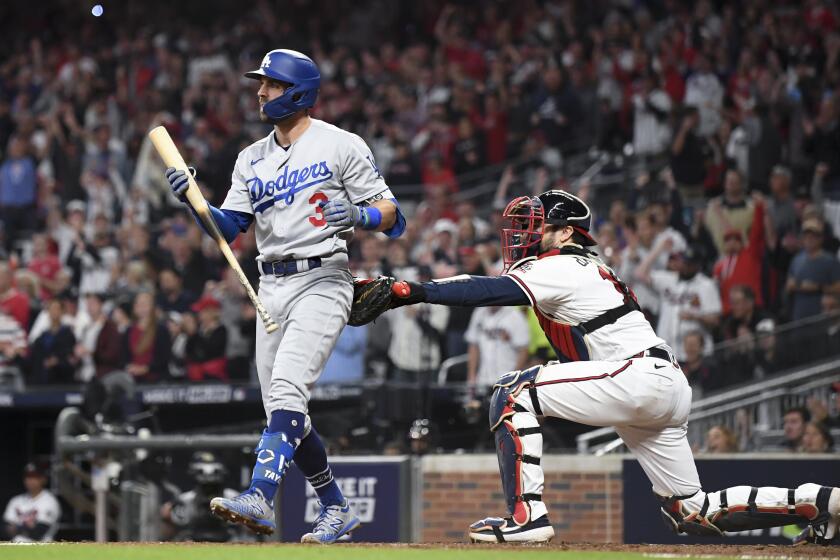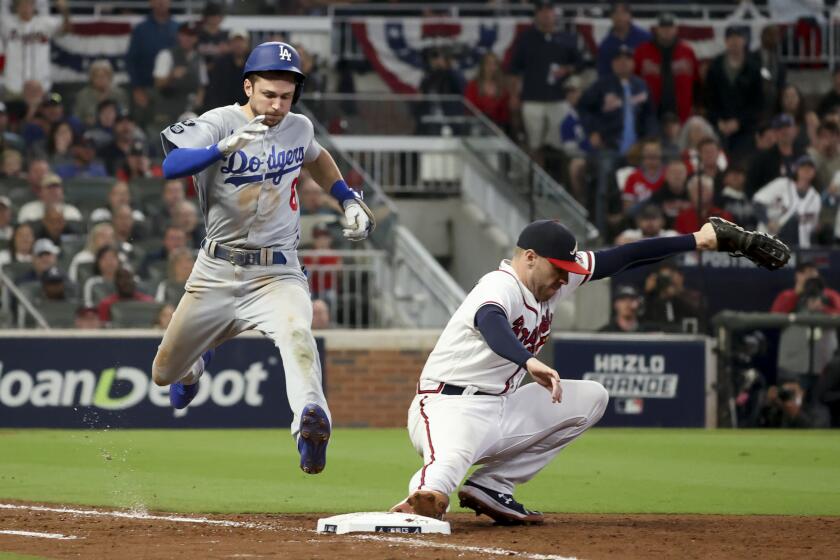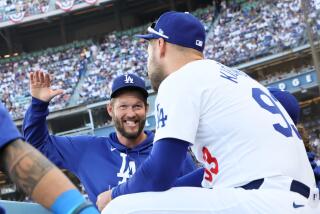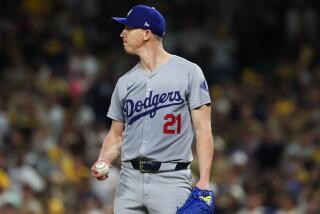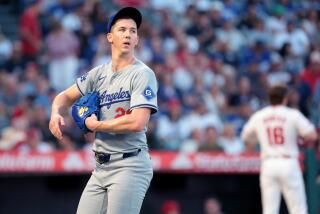Column: Dodgers’ postseason pitching experiment was the Bill Buckner of strategies
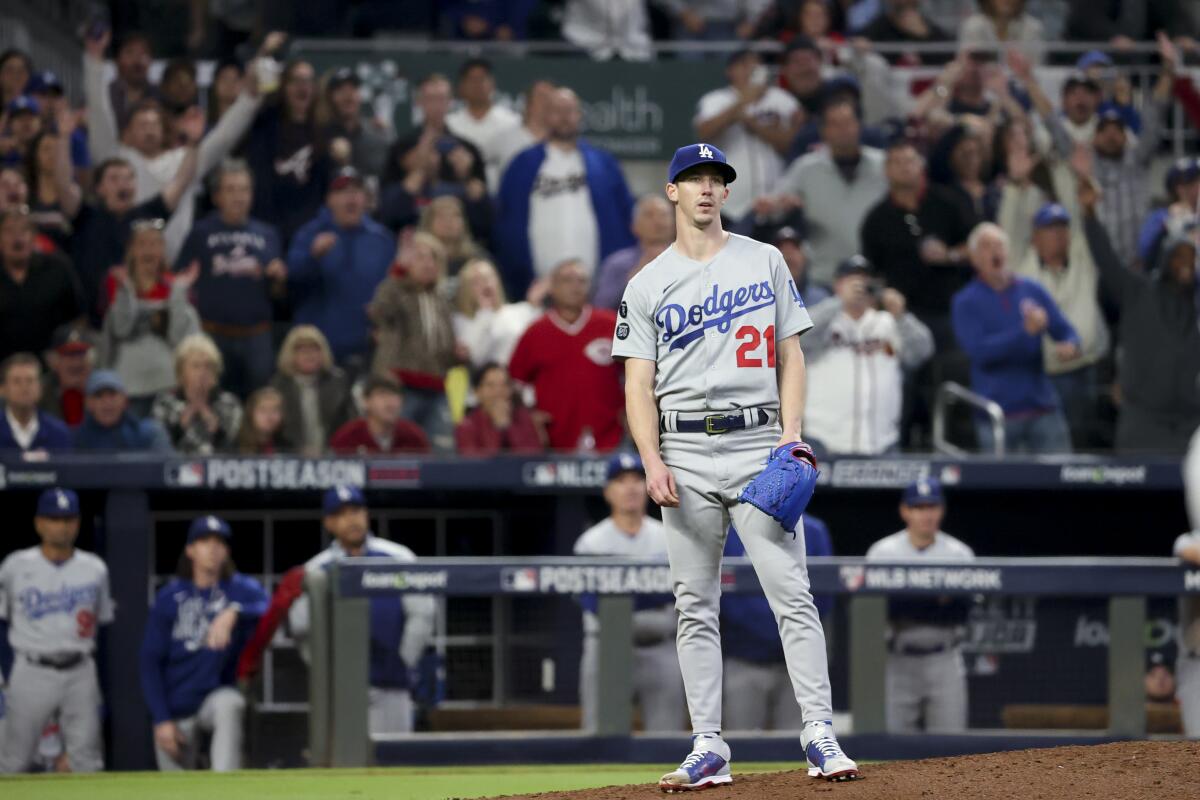
- Share via
ATLANTA — This was the management equivalent of Bill Buckner’s blunder at first base, of Willie Davis’ three errors in center field, or Steve Bartman’s gaffe down the left-field line.
Actually, this was worse.
Buckner’s, Davis’ and Bartman’s teams had a chance to recover from their respective mistakes. Now that the National League Championship Series is over, it’s evident the Dodgers were finished once Andrew Friedman and the geniuses in the front office decided the postseason was the right time to experiment.
The $260-million Dodgers were officially eliminated on Saturday night in a 4-2 defeat to the Atlanta Braves, who won the best-of-seven matchup by an identical margin and earned the right to get destroyed by the Houston Astros in the World Series.
Southern California native Tyler Matzek shut down the Dodgers’ best chance to come back in the seventh as the Braves advance to the World Series.
Starter Walker Buehler was pitching on three-days’ rest and looked like it, giving up four runs, seven hits and three walks in four innings.
Buehler pitched because Max Scherzer couldn’t — the remnants of a decision made in the previous round.
Hall of Fame pitcher and TBS broadcaster Pedro Martinez, who knows a thing or two about mistakes made by the Dodgers, posted on his Twitter account, “@Dodgers analytics dept really messed up probably the best rotation in all of baseball. That’s why we’re not seeing the sharp breaking balls and the giddy up fastballs. They need to figure out a way to let starters be who they really are and let them pitch how they are used to.”
In other words, the Dodgers shouldn’t have done what they did against the San Francisco Giants in Game 5 of their NL Division Series.
They shouldn’t have deployed 20-game winner Julío Urias as anything other than a starter. They shouldn’t have used Scherzer as a closer.
Readers’ letters printed in the Sunday edition of this newspaper reflected the mistaken view this was manager Dave Roberts’ idea. To be clear: The plan to have Urías follow openers Corey Knebel and Brusdar Graterol in Game 5 of the NLDS, which ultimately led to Roberts calling on Scherzer to pitch the ninth inning, was hatched by the front office.
A difficult World Series title defense that included the Dodgers chasing the rival Giants ended up costing the Dodgers vs. the Atlanta Braves.
The choices reverberated in throughout the NLCS.
Scherzer was unable to make his scheduled start in Game 1, which the Dodgers lost. Scherzer said his arm felt dead when he pitched in Game 2, which the Dodgers also lost.
Urías pitched in relief in Game 2, diminishing his effectiveness in Game 4, another game the Dodgers lost.
Scherzer couldn’t pitch again in Game 6, and the Dodgers’ season was over.
Roberts always said he knew that asking Scherzer to close out the NLDS could have a cost. However, the manager said before the game on Saturday, “Could I foresee where we’re at now? No. But we still have to make the decision that gets us to this point.”

The Dodgers’ season ended after losing Game 6 of the NLCS to the Atlanta Braves. Los Angeles Times sports writer Jorge Castillo, along with columnists Dylan Hernandez and Bill Plaschke, break down what happened and where the Dodgers go this offseason.
In the previous seasons, the Dodgers counted on extraordinary efforts by individual pitchers to make up for their shortcomings.
Last year, it was Urías, who as a super swingman camouflaged their vulnerabilities in the bullpen. Before that, there were seasons in which they relied on Clayton Kershaw to make starts on short rest to compensate for the lack of rotation depth.
This time, they didn’t have anyone to bail them out.
Trevor Bauer was visible only to followers of his social media accounts, as he remained on administrative leave related to accusations of sexual assault made against him.
Kershaw was in a blue sweatshirt, leaning against the railing in front of the Dodgers’ bench.
Scherzer was too.
In explaining why he couldn’t pitch, Scherzer offered insight to why he remains an elite pitcher at 37. Told how some pitchers in his condition would lie and take the mound regardless of how they felt, Scherzer replied, “I don’t lie.”
Scherzer elaborated: “Guys, when they lie, they go out there and they take on too much, then they blow out. That’s the ultimate risk here.”

The Dodgers were eliminated from the postseason after losing NLCS Game 6 to the Atlanta Braves. Dodgers manager Dave Roberts discusses what happened and what the offseason will bring.
He’s no Kershaw, and that’s meant to be neither a criticism nor a compliment.
Kershaw would have taken the mound if he were in Scherzer’s position, consequences be damned. The mindset explains why so many people were overjoyed last year to see Kershaw finally win a World Series.
Kershaw is now at a crossroads in his career at 33, as he will become a free agent after a season in which he sustained a season-ending forearm injury.
Scherzer’s more cautious approach has made him one of the most resilient pitchers in baseball. He was the model free agent, worth every penny of the seven-year, $210-million contract he signed with the Washington Nationals before the 2015 season.
He will be a free agent again this winter, positioned to sign a three-or four-year deal that could be worth nine figures.
Scherzer wasn’t about to risk that, which was entirely his right.
“My arm’s been locked up the past couple of days,” he said. “After that Game 2 start, I knew I was going to be sore for a couple of days but it was just general muscle soreness across my arm, body. That’s normal when you’re in the playoffs and you overcook yourself. I’ve been dealing with that many times. I just wasn’t recovering. I got to basically Day 4 and it felt like Day 1 still.”
The Dodgers made a hefty financial commitment starting in 2020 to make the Dodgers a perennial World Series contender, but will they continue to pay out?
Scherzer said he couldn’t throw at 90 feet until Friday.
Looking back, Scherzer said he didn’t think pitching the ninth inning in San Francisco was solely the reason.
“It’s a cumulation of everything,” he said. “It’s a work capacity issue of taking all the starts and putting them together. It’s never just one outing that gets you in trouble.
“Over the course of my career, I’ve been really good about being able to communicate with my manager, all my managers, of where my arm’s at to where if I make a start, I know where to stop to be able to recover and get back about that.”
Scherzer said he said he thought he could pitch in Game 7 if the NLCS, if the series reached that point. But he was measured in his optimism.
“I just don’t know where my line will be,” he said. “I don’t know how much, how little.”
He won’t ever find out. The Dodgers’ season is over.
Photos from Game 6 of the National League Championship Series between the Dodgers and Atlanta Braves at Truist Park in Atlanta on Saturday night.
More to Read
Are you a true-blue fan?
Get our Dodgers Dugout newsletter for insights, news and much more.
You may occasionally receive promotional content from the Los Angeles Times.

